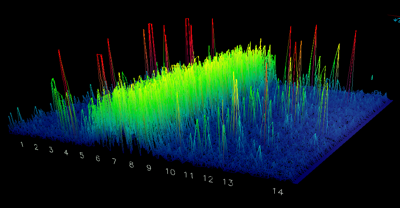What's going on in your communication space?
Lots of devices these days are using the 2.4 GHz radio spectrum: WiFi (802.11) devices, Bluetooth, ZigBee, and so on. It’s also the same frequency used in microwave ovens, so they pollute the communications space more. All this noise can lead to devices interfering with each other, causing a loss in performance. But how would you know?
Yesterday Laura brought home a cool little gadget, called a WiSpy, it’s a neat little spectrum analyser that takes readings over the 2.4 GHz range. Here you can see a reading of our house when there’s not much going on on our home network:

There’s a bigger version of the image here. The image shows a map of the spectrum in the typical WiFi range, showing where channels 1 to 14 are, and time going back into the image. You can see some random noise, which is roughly in line with wifi channels 6 and 11, which are the channels we and our neighbours use. However, on the whole, there doesn’t seem to be much interference in our neighbourhood.
At home we’ve been happily using an AppleTV for a while, to let us watch programs that our Mac Mini has recorded for us. The AppleTV is a neat little device that sits next to your TV (or monitor in our case) and sucks all the videos out of your iTunes library so you can watch them at your leisure. All well and good, but we’d noticed that when the AppleTV is downloading all your videos, it seems to hammer the network quite a bit, so we thought we’d have a look at that. We set the AppleTV syncing, and here’s what you see:

Ouch! There’s a bigger version of the image here. You can see that the syncing really hits the network hard. No wonder our world slows down a bit when it’s syncing – thankfully it only does that briefly after a new TV show has been recorded.
Alas we don’t have a microwave, otherwise I’d have had fun testing that too :)
I can heartily recommend the Wi-Spy, though it’s not cheap at $199, but it does the business.
- Next: Heely Art
- Previous: ssh plugin for QuickSilver
- Tags: Geek